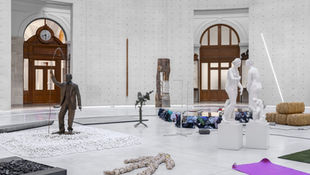
Woody Allen's Manhattan
New York City has long been an iconic setting for countless films, but few filmmakers have captured its essence as profoundly and consistently as Woody Allen. Throughout his illustrious career, Allen has portrayed the city in countless ways, using its streets, parks, and neighbourhoods not just as backdrops but as central characters in his narratives. For Allen, New York is not merely a place - it's a reflection of his characters' inner worlds, an expression of their neuroses, desires, and personal struggles. His films embody a love letter to the city, though not always in the most conventional or idealised sense.

Woody Allen’s relationship with New York is complex, oscillating between adoration and critique, nostalgia and criticism. His films often depict a city that is both a source of existential confusion and a vibrant backdrop to personal discovery. Throughout his career, Allen has often played the neurotic, self-absorbed intellectual, seeking meaning and understanding in a world that can seem both overwhelmingly beautiful and endlessly frustrating. This ambivalence can be traced back to Allen's own life. Born in Brooklyn in 1935, Allen grew up in a New York that was dramatically different from the bustling metropolis of today. The city of his youth was more gritty, more working-class, and very different from the cosmopolitan playground for the wealthy that it has become in recent decades. For Allen, New York represents the merging of cultural opportunity and personal alienation - two forces that continue to define much of his work.
Allen’s early films, particularly those from the 1970s, reflect New York as a city where dreams are pursued, yet personal failure and disappointment lurk just around the corner. In his first major feature, Take the Money and Run (1969), Allen presents New York not as a glamorous paradise, but as a concrete jungle teeming with the absurdity of human ambition. The protagonist, Virgil Starkwell, is an inept bank robber whose failed heists are as much a reflection of his inadequacies as they are of the urban environment in which he struggles to thrive. Similarly, Annie Hall (1977), perhaps Allen’s most famous and beloved film, uses New York as a backdrop to explore the complexities of love, identity, and neuroses. The film captures the city at its most intimate - through walks in Central Park, nights in jazz clubs, and moments of quiet reflection in urban apartments. While the film’s setting remains quintessentially New York, it also draws attention to the city’s isolating qualities, showcasing the emotional distance between characters despite being in such proximity geographically.

Through his neurotic characters, Allen conveys a sense of alienation - a feeling that is particularly poignant in the context of New York’s overwhelming size and pace. In films like Manhattan (1979), the city becomes a symbol of both ambition and futility, as the protagonist, Isaac Davis, a middle-aged writer, embarks on a series of misguided relationships while wrestling with his own artistic and personal crises. New York, in this instance, serves as a metaphor for the characters’ search for meaning in a world that often seems indifferent to their struggles.
One of the defining characteristics of Woody Allen’s New York is its association with intellectualism, culture, and high society. In many of his films, New York is portrayed as a hub of intellectual activity, where art, literature, and philosophy are not just part of the cultural landscape but serve as essential components of the characters' identities. In Manhattan (1979), the film's protagonist is an aspiring writer who lives in an apartment overlooking the city. His life revolves around the pursuit of intellectual and romantic relationships, despite his personal confusion and existential dilemmas. In scenes of dinner parties and intellectual debates, Allen’s New York is a city of ideas, where culture is an almost sacred pursuit. This portrayal of New York as an intellectual haven is further explored in Husbands and Wives (1992), a film about two couples whose marriages are falling apart. While the film's themes are rooted in the personal crises of the characters, the setting is equally important. The characters attend art galleries, engage in conversation about literature, and grapple with the intellectual demands of modern life - all set against the backdrop of New York’s urbane culture. Allen’s New York is one where the pursuit of knowledge and sophistication can both elevate and entrap individuals, leading to existential despair as much as artistic fulfilment.
Despite the many depictions of New York’s harshness and alienation in Allen’s films, there is also a sense of romanticism that pervades many of his works. Allen’s New York is not simply a cold, indifferent place but one filled with warmth, nostalgia, and beauty. The iconic shots of the city’s skyline in Manhattan have become symbolic of this cinematic vision - a black-and-white homage to the city's grandeur and elegance. The film opens with a sweeping aerial shot of the city, accompanied by George Gershwin’s "Rhapsody in Blue," and the image of New York is rendered as almost divine - a symbol of artistic and intellectual aspiration. In other films, such as The Purple Rose of Cairo (1985) and Midnight in Paris (2011), Allen portrays New York through the lens of nostalgia and longing. These films evoke the idea that New York, like the past, is a place that may no longer exist in its original form but remains an essential part of the characters' sense of self. In The Purple Rose of Cairo, for instance, the protagonist escapes her mundane life by watching films in a theatre, where the fantasy of the cinema becomes her escape from the harsh realities of her existence. While not strictly set in New York, the film echoes Allen’s portrayal of the city as a place of both escape and creative expression.

While Allen’s New York often feels like a stage for intellectual debates and romantic entanglements, it also functions as a place where characters undergo significant personal transformation. Alice (1990) is a film that features the city as a landscape for self-discovery and healing. In this film, a woman’s search for meaning in her life leads her to confront her past, her relationships, and her desires. Through its depictions of Manhattan’s streets and alleyways, the film presents New York as a city that, for all its distractions, offers moments of quiet reflection and personal growth. Similarly, in You Will Meet a Tall Dark Stranger (2010), New York plays a pivotal role in the characters' attempts to overcome their crises. The city, with its ever-changing rhythms and contradictions, provides both a backdrop for the characters’ turmoil and a source of unexpected epiphanies. Allen’s vision of New York here reflects his broader themes of fate, illusion, and self-deception.
As much as Allen’s New York remains timeless, it is also a city in transition. Over the decades, the city has undergone profound changes, both in terms of its physical landscape and its cultural atmosphere. The gritty, working-class New York that Allen grew up in has been replaced by a more sanitised and affluent city. This transformation is often reflected in his films, where the changing nature of New York mirrors the evolving challenges and desires of his characters. In Manhattan Murder Mystery (1993), for example, Allen's characters are caught in gentrification, with their familiar, old-world neighbourhoods being replaced by sleek, modern condos. The film is infused with a sense of nostalgia for a New York that no longer exists, as the characters yearn for a simpler time when their dramas seemed less entwined with the city's rapid growth.
In many ways, Woody Allen’s New York has become as much a character in his films as the people who inhabit it. His portrayal of the city reflects his vision of life: a mix of intellectual inquiry, existential questioning, romantic yearning, and a dash of humour. Through the lens of his work, New York becomes more than just a setting - it is a place of self-discovery, an emotional battleground, and a stage for both personal failure and transcendence. Whether portraying the city’s intellectualism, beauty, chaos, or nostalgia, Allen has shaped how we see New York in cinema, making it an integral part of his stories. Through his lens, we see a city that is both a dream and a nightmare - a city that provides a stage for personal and intellectual reinvention but also forces its characters to confront their deepest flaws and desires. In Allen's cinematic universe, New York is a city of contradictions, of possibilities and limitations, a place where characters come to understand themselves or fail to do so, against the backdrop of a constantly changing urban landscape.





